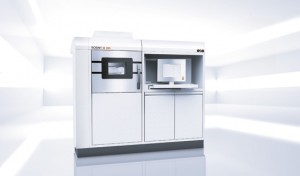Admittedly I have never seen a functioning EOS machine but it has one feature that just seems like fun. Titanium. That’s right, 3D printing in one of the hardest manufacturing materials around. Billed as “for aerospace and engineering applications and biomedical implants” this is one of those features that will break new technological ground. One of the most exciting things about 3D printing is that designers and engineers are not limited in the geometry of the parts they can create, at least compared to standard machining. The parts that can be dreamed up by medical researchers are suddenly a reality and once these machines become more popular (read: less expensive) the developments it will lead too are nearly endless.
The EOS printers can work with a number of other metals as well. Nickel Alloys, Hardened stainless steel, Cobalt Chrome, all of these offer unique material properties which should be exciting for engineers in all fields. Similar to the ExOne series (early in this series of posts) the EOS systems are designed to replace traditional manufacturing processes. Granted a handful of hackers may want a nearly room sized machine in their private garage but that is a very small market. Instead these machines are intended for the modern engineer, someone who was trained in computer aided design, stress analysis, and computer simulations but does not necessarily have the skills or accesses to control everything in a machine shop. As with most additive manufacturing machines the EOS takes a 3D model from bits and bytes and turns it into a physical product albeit often in a much more complex material than the competition.
10 Unique 3D Printers
Previous: ZPrinter by ZCorp
Read more about 3D Printing on 3DEngr

